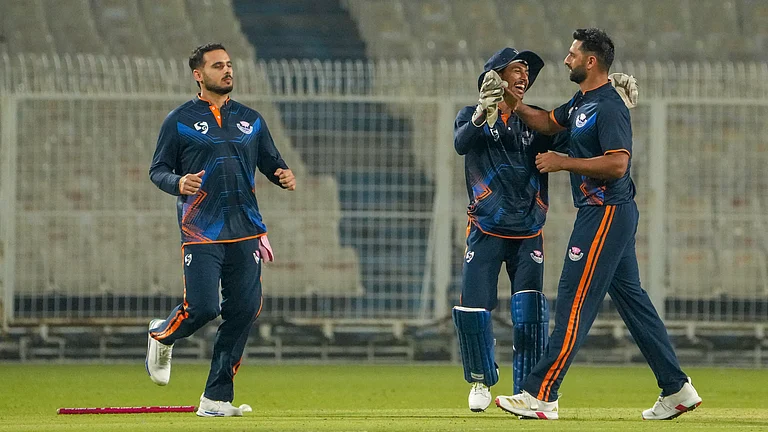Inside a tea stall at Sahebghata bazar in Kaliaganj, an assembly constituency in Uttar Dinajpur district on India’s border with Bangladesh, around a dozen people were glued to the TV, watching a Bengali newschannel with known BJP leanings. It was April 15, and the Election Commission had convened an all-party meeting on a proposal for modification of the poll schedule for the remaining phases, mindful of the worsening Covid situation. The state’s ruling party, the Trinamool Congress, wanted the last three phases, scheduled on April 22, 26 and 29, to be clubbed together. At the tea stall, the viewers were anxiously waiting the EC’s decision. None wanted a joint phase; they thought it would be to the TMC’s advantage.
Asked if they would not consider the human cost that conducting the elections as per the schedule will entail, Joydeb Saha, a vegetable vendor, says, “Covid is a hoax. The TMC is spreading panic to win the elections. The polls are matter of only two more weeks. But if they return, it would be five more years.” His comment came in the backdrop of a steady rise in the number of COVID-19 positive cases in Bengal over the past week.
Yet most people seemed more bothered about the elections than the worsening pandemic. The atmosphere in Kaliaganj was tense, because in the Lok Sabha elections of 2019, the BJP had a massive lead over the TMC in this assembly segment of Raiganj seat. But in the assembly by-election held six months later the TMC won it by a thin margin.
Anil Bhattacharya, a farmer from the neighbouring constituency of Itahar, was equally unconcerned about the spread of the pandemic. “My son says there would be no industries in Bengal as long as Mamata Banerjee stayed. Industrialists would not trust her because she had forced the Tatas out (in 2008),” he says. Bhattacharya’s son, who has an MA in sociology, knew the organisers of Akhil Bharatiya Vidyarthi Parishad (ABVP), the student wing of the RSS, during his student days and campaigned for the BJP ahead of the polls, expecting the employment scenario to change.
In south Bengal, in North 24-Parganas and Calcutta, where the pandemic had taken a dangerous turn over the following week, people still attended election rallies in their thousands, until the EC banned any gathering of over 500 people on April 22. That day, the state reported 11,948 new cases and 56 deaths, with a positivity rate of 22.47 per cent. But those thronging the rallies argued, depending on their affiliation, that they were fighting a more dangerous virus: Mamata Banerjee’s rule and the “hate brigade of the BJP and RSS” respectively.
At street corner meetings across the metropolis, BJP leaders exhorted people not to miss this chance to dethrone Mamata’s government, so that the state’s youth would no longer need to migrate—an opportunity to junk the “destructive leftist culture” of four-and-a-half decades. “Youths are coming to our events in large numbers as they are fed up with the employment scenario, being forced to migrate to other states for jobs. The pandemic has hit migrant workers hard; they are banking on us,” says BJP state general secretary Sayantan Basu.
Migration researcher Sabyasachi Basu Ray Chaudhuri, a professor of political science, says that West Bengal drew more in-bound migrant workers till the 1990s, but the situation changed thereafter. However, there was no data to determine if migration increased during TMC rule. There was no major ‘push-factor’ since 2011, he says, to prompt a spike in out-bound migration, except for cyclone Aila in 2009, that left thousands of acres uncultivable for several years. “However, there have been ‘pull-factors’ in the form of better opportunities in other states. These opportunities opened up with the improvement of telecommunication and transport,” Basu Ray Chaudhuri says. He cites ‘circular migration’ as another factor: “Many people from Bengal are migrating to Kerala because workers from Kerala have migrated abroad, creating a need for workers.”
The TMC defiantly counters the migration narrative with a volley of its own. It has claimed credit for the state bagging first position in implementing the Mahatma Gandhi National Rural Employment Guarantee Act for four years since 2015-16 and for a boom in the MSME sector. Then, it talks about how Bengal topped the ‘ease of doing business’ ranking in 2018, claims to have revived the textile, handicrafts and tourism industries and cites the Union ministry of rural development’s 2019 national awards that ranked Bengal second in ‘financial inclusion’ and first in ‘non-farm livelihood’ under the Deen Dayal Antyodaya Yojana–National Rural Livelihood Mission.
For the COVID-19 situation the TMC squarely blames the EC and the BJP. “The EC planned an eight-phase election stretched over a month and the BJP brought in people from outside,” alleges top TMC leader and minister Firhad Hakim.
By April 26, the day of the seventh phase, the panic over the pandemic had spread, with new 15,992 cases and an alarming 32.93 per cent positivity. Consequently, South Calcutta recorded a low turnout of 61 per cent, while in the urban West Burdwan district voting was at 72.44 per cent. The state’s overall polling rate in five districts on April 26 also stood at 76.9 per cent—lower than the rate in the earlier phases.
The rampant pandemic seemed to have changed the character of the campaign as well. The initiative now lies with the TMC, as it highlights how the Narendra Modi government has been caught unprepared, leading to a nationwide crisis.
By Snigdhendu Bhattacharya in Calcutta


























